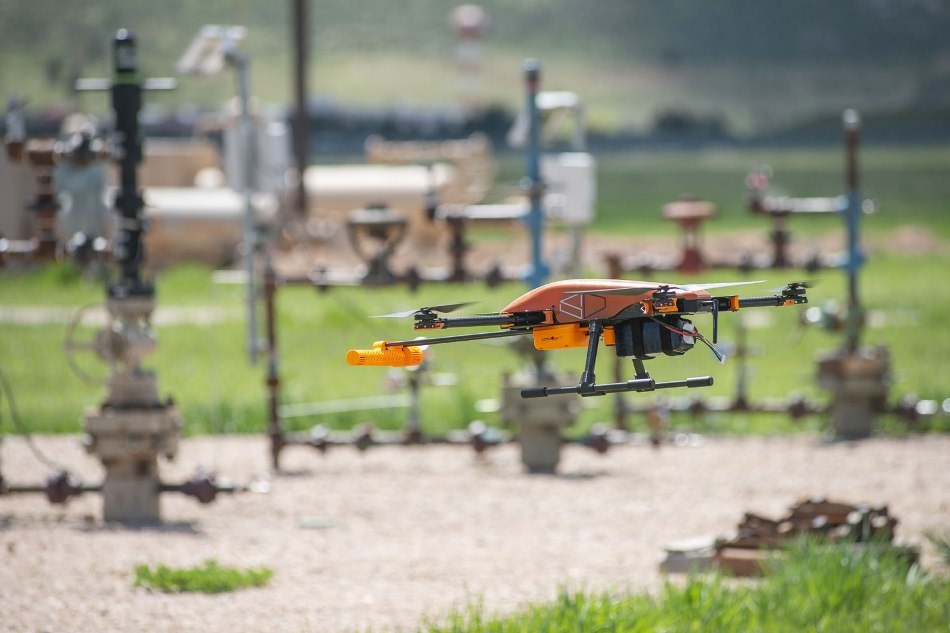Jun 10 2019
Natural gas flowing through pipelines from wells to stovetops is susceptible to leakage, endangering the safety and health of humans as well as the planet’s health.
 A drone-based methane detector competes in the Mobile Monitoring Challenge at a natural gas facility in Colorado. (Image credit: Sean Boggs/Environmental Defense Fund)
A drone-based methane detector competes in the Mobile Monitoring Challenge at a natural gas facility in Colorado. (Image credit: Sean Boggs/Environmental Defense Fund)
In the last decade, natural gas leaks and explosions in U.S. residential and commercial neighborhoods have caused the deaths of 73 people, injured 412 others and resulted in over $500 million in property damage. Gas leaks and other emissions throughout the industry discharge a third of all man-made methane, a greenhouse gas 36 times more formidable than carbon dioxide. Scientists at Stanford and elsewhere are hunting for rapid and economical ways of finding leaks throughout the natural gas supply chain in an effort to curtail damage and save lives.
“While a large portion of methane in the atmosphere comes from agriculture and livestock, natural gas leaks are found throughout the gas distribution system,” said Stanford professor of geophysics Mark Zoback, director of the Natural Gas Initiative, which funds much of the research at Stanford detecting and mitigating leakages.
When burned to create electricity, natural gas discharges about half the carbon dioxide per kilowatt-hour than coal does, in addition to less nitrogen and sulfur oxides, making it an attractive substitute to coal.
However, the U.S. Environmental Protection Agency estimated that the oil and gas industry released approximately 8 million metric tons of methane in 2016 –equal to emissions from 43 million cars annually. A 2014 study carried out by Adam Brandt, an associate professor of energy resources engineering at Stanford, found that such leaks can refute some but not all of the climate benefits of changing from coal to natural gas, as some specialists, including Zoback, have backed.
“Most gas leakage is associated with a relatively small number of large sources. We’ve got to find and fix the biggest leaks if we want to build a safer, cheaper and less harmful system,” Zoback said.
Consumer safety and health
When leaks occur near residential and urban areas, they can cause explosions and fires and pose some of the extreme threats to human safety, besides climate effects. Among those involved in finding these types of leaks are Stanford’s Rob Jackson and private-sector scientist Robert Ackley, president of Gas Safety USA, a Massachusetts leak-monitoring firm.
Both of them have driven through urban areas in a car that seems fairly ordinary, except for the odd antenna protruding from its roof. Unknown to bystanders, Jackson and Ackley stare at data on a screen, waiting for the revealing ping to alert them of a gas leak close by. They use a laser-based methane analyzer and the car’s odd antenna, which measures wind direction and speed, to survey leaks.
This type of survey in Cincinnati showed that pipeline replacement programs had lowered gas leaks by up to 90%. While working at Duke University in 2011, Jackson and colleagues discovered 3,000 leaks in Boston in partnership with Boston University scientists. That mapping ultimately resulted in policy reform in Massachusetts, Jackson said. He later carried out a similar study in Washington, D.C., and discovered twice as many leaks as there were in Boston. He and his team are currently working on building and home leak detection techniques to record emissions from the curbside.
“Any leak is potentially explosive,” he said. “We’re trying to help engineer the system to be safer and more efficient.”
Our planet’s safety
While leakages in residential areas pose a threat to human safety, leakage in every piece of the natural gas industrial chain – valves, wellheads, gauges, pumps, compressors, and pipe connectors – has serious consequences for the climate.
Oil and gas companies want to help decrease the quantity of lost gas because of the related costs and liabilities. According to a 2012 study, global fugitive methane costs more than $30 billion in lost revenue every year. Moreover, just 5% of leaks in the transport and production system are accountable for more than half the methane emissions, Brandt learned in 2016.
“The gas industry cannot credibly claim to be a responsible player in global sustainability if it continues to emit significant quantities of methane through its operations,” Brandt said.
Collaborating with postdoctoral scholar Arvind Ravikumar, Brandt recently headed the Mobile Monitoring Challenge – a competition to find the most economical and accurate means of locating natural gas leaks – together with colleagues from Stanford, Colorado State University and the Environmental Defense Fund.
During the contest last year, trucks rumbled by, drones whizzed overhead, and helicopters zoomed through the sky at controlled testing facilities in Colorado, Fort Collins, and Sacramento, California.
The competition results are expected to be announced soon, and when they are, scientists at Stanford and beyond will possess a new tool to help locate and prevent hazardous natural gas leaks at pipelines and wells and near homes.